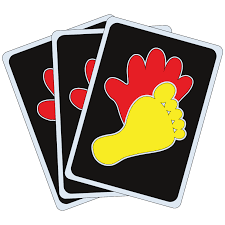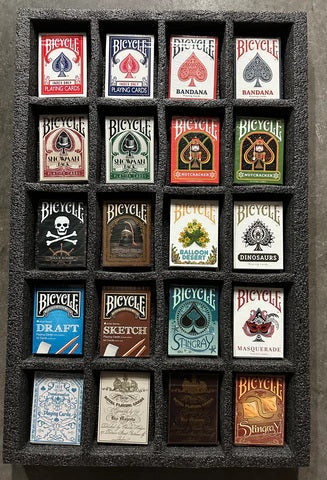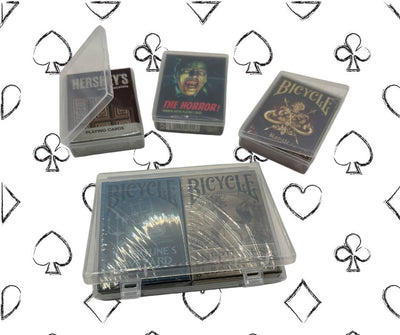
(The set up of a traditional Hand and Foot game)
Card Game Rules
Hand and Foot is a popular variation from the rummy type game of Canasta. It can be described as a simpler, easier version of Canasta for beginners. Hand and Foot uses about 5 or 6 decks of standard playing cards and is played with 2-6 players. The objective of Hand and Foot is to be the first to get rid of all of your cards and for your team to have the most points.
For more rummy type games, check out our guides for Classic Canasta and Gin.
Set Up
Before the game begins an initial dealer must be chosen. To do so, every player is given a card from a shuffled deck and whoever receives the highest card becomes the first dealer. Ties are broken by a repeated deal. The initial dealer shuffles the deck and the player to their right cuts it. The dealer then passes two sets of 11 cards one by one clockwise to each of the 4 players. The first set of 11 is called the Hand and the last set of 11 is called the Foot. The remaining cards are placed faced down to form the stock. The top card of the stock is turned upright and placed to the side to form the discard pile. The dealer position rotates clockwise at the end of each round.
Teammates sit across from each other and work together to form the more melds than the other team.
Melding
Melds are formed by matching cards of the same rank. A meld must begin with at least 3 cards. Melds are shared within the teams so, teammates can build upon their own melds.
Wildcards
The Jokers and 2s in the deck are wildcards and can be used to build upon any meld. Melds must have, however, more natural cards than wildcards in them.
(In Hand and Foot, there are two stacks that players must meld to win)
How to Play
The gameplay moves clockwise and begins with the player clockwise to the dealer. At the beginning of their turn they must take a card from either the stock or the discard pile. To take a card from the discard pile, the top card must either begin a meld or build upon one already made. If you take from the discard pile, you must take all of the cards in the discard pile. At the end of your turn, you must discard one card.
Players must start with their Hand pile while their Foot pile is laid face down. Once the play all of the cards in their Hand pile, players move to their foot pile.
Books
In Hand and Foot, a pile of 7 cards is called a book. If none of those cards are wild, it is called a red book. If any of the cards are wild, it is called a black book. When books are made, the pile is tacked faced down and a card with the same color of the book is placed face up on top of the stack.
Going Out
Teams must have made a red book and a black book before they are allowed to “go out”. They must also have played all of their cards in both their Hand and their Foot.
Scoring
After a player goes out, the round has ended, and scores are tallied as follows:
Red books are worth 500 points
Black books are worth 300 points
Wild card books (books made from 2s and Jokers) are worth 1500 points
Jokers are worth 50 points
2s are worth 20 points
Aces are worth 20 points
8s through Kings are worth 10 points
4s through 7s are worth 5 points
Black 3s are worth 5 points
Red 3s are worth 100 points
Going out is worth 100 points
Points from the cards in the team’s remaining hand are deducted from the points from the team’s played cards.
For more information on the game's rules, check out Pagat's article here or Wikipedia's article here.
History
In 1939, Canasta was invented by Segundo Santos and Alberto Serrato who wanted to create a quicker game than bridge. Canasta in Spanish means “basket” and refers to the basket Santos and Serrato normally put their cards in. The game was an instant success in their local card clubs but, became a global sensation in the 1950’s. Countless books were written on the game then, specialty decks were sold and Canasta overtook Bridge aa the popular pastime. While the exact origins of Hand and Foot Canasta are unknown, the game first came about in the 1970s, with its own specialty decks arriving in the 1980s.
For more information on the history of Canasta, check out game developer Philip E. Orbanes' article here.
Variations
Because Hand and Foot is in itself a variation of Canasta, the following games are also variations of Canasta.
Two Player
In Two Player Canasta, 15 cards are initially dealt. If a player draws from the stock, they must draw 2 cards instead of the normal one. Additionally, a player needs to complete two canastas in order to go out and end the round. All other rules of Classic Canasta apply including the 5000 point objective.
Samba
Samba is practically Classic Canasta but, with increased values for everything. Three 52 card decks are in play, totaling 162 cards. Instead of a 5000 point objective, teams have to reach 10000 points. Melds can be made by cards of a kind and cards in sequence. Six red 3’s are worth 1000 points. Melds can only have two wildcards in them. For teams with 7000 points or more, the first meld of a player must be least 150 points.
Looking for more card games to play? Check out this article:
40+ Great Card Games For All Occasions
About the author: John Taylor is a content writer and freelancer through the company Upwork.com. You may view his freelancing profile here. He has a B. A. in English, with a specialty in technical writing, from Texas A&M University and a M. A. in English from the University of Glasgow. You may view his previous articles about card games here and his LinkedIn profile here.







60 comments
Answers to posted questions:
1)Red & Black Threes: Red 3 value is Negative 300 points, Black 3 is Negative 50 points. Card should be discarded as soon as possible. If game ends and card remains in Players hand, then the point value is subtracted from the players score.
2) When picking up the discard pile, you need to lay down your required points first, then have 2 cards of the same top card on the pile
3) Discard pile is frozen (i.e., You cannot pick up) if the top card is a 2 or 3 or Joker.
I have a question… how do the Red 3s play out in the game and scoring..
When picking up the discard pile, do you need to lay down your required points first, then have 2 cards of the same top card on the pile? Or do you count that discarded card as part of your required points, thus making it not necessary to lay down the points + 2 cards to pick up the discard pile?
I cannot find a Hand & Foot Card Game score sheet to download on the internet. I have searched all the Canasta site I can find. Could you help me?
Diane Anderson
lendianders@yahoo.com
What are the rules for freezing the pile.